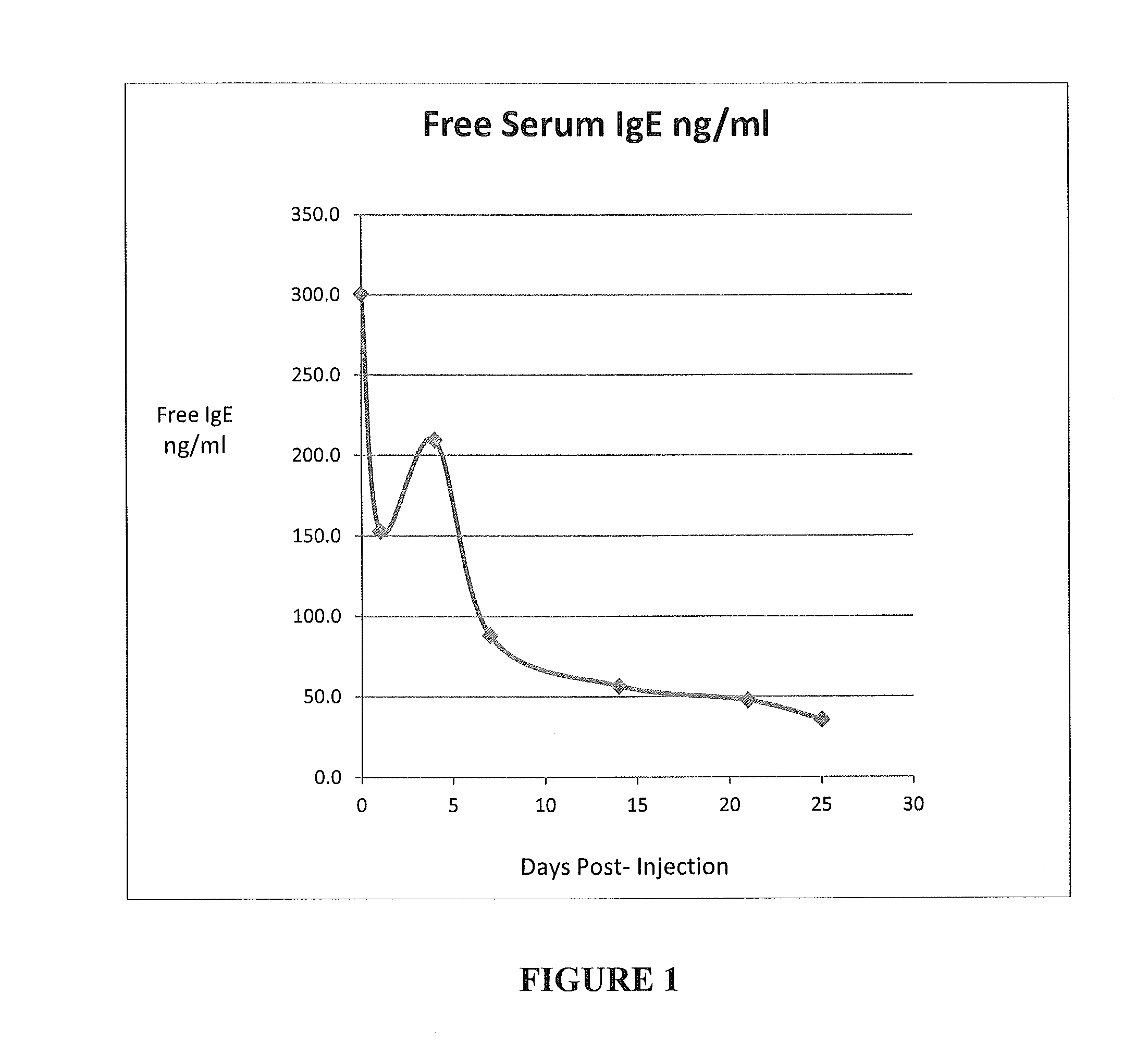Treatment of allergic diseases with recombinant antibodies
a technology of recombinant antibodies and allergic diseases, applied in the direction of antibodies, fused cells, peptides, etc., can solve the problems of severe side effects and less than optimal outcomes, and achieve the effect of lowering the free ige level
- Summary
- Abstract
- Description
- Claims
- Application Information
AI Technical Summary
Benefits of technology
Problems solved by technology
Method used
Image
Examples
example 1
In vitro and Preliminary In vivo Studies
[0106]Mouse monoclonal antibody 5.91 (mAb 5.91) was selected for extensive characterization from a panel of monoclonal antibodies made against canine IgE (Hammerberg, U.S. Pat. No. 7,470,773 (2008). This monoclonal binds canine IgE expressed on the surface of dog B cells committed to IgE production and binds B cells expressing the low affinity IgE binding receptor, CD23, occupied by IgE, as well as dendritic cells and basophils expressing the high affinity receptor for the epsilon chain of IgE, occupied by IgE in peripheral circulation (Jackson, Orton and Hammerberg, Vet Immunol. Immunopathol. 85, 225-232 (2002)). This is the same binding profile shown by the human IgE-binding omalizumab.
[0107]More recently we have found that mAb 5.91 blocks the binding of biotinylated canine x mouse heterohybridoma IgE to canine C2 mast cells in vitro and to circulating monocytes and B cells in whole blood samples. In this experiment mAb 5.91 was incubated wi...
example 2
In Vivo Activity of Monoclonal Antibody 5.91
[0109]This example shows the decrease in serum “free IgE” in a single 10 Kg beagle dog injected subcutaneously once at day 0 with 30 mg of mouse monoclonal antibody 5.91.
[0110]Blood was collected for serum just before injection and at 1, 4, 7, 14, 21 and 25 days post-injection. The ELISA for measuring “free IgE” was conducted with a rabbit IgG anti-canine IgE trapping antibody and recombinant human High Affinity IgE Receptor (Fc s RI) labeled with biotin and detected with streptavidin peroxidase. Data is given in FIG. 1.
example 3
Cloning of MAb 5.91 Light Chain Variable Region (VR)
[0111]An RNA template was first prepared. Then, using a first set of PCR primers, VL-CK was successfully cloned. By DNA sequencing of VL DNA, the VL nucleotide and amino acid sequences were determined, and are given in Table 1.
TABLE 1Sequence of VLDNA (5′ to 3′):(SEQ ID NO: 1)gacatccagatgactcagtctccagcctccctatctgcatctgtgggagaaactgtcaccatcacatgtcgagcaagtgggaatattcacaattatttagcatggtatcagcagaaacagggaaaatctcctcagctcctggtctataatgcaaaaaccttagcagatagtgtgccatcaaggttcagtggcagtggatcaggaacacaattttctctcaagatcaacagcctgcagcctgaagattttgggagttattactgtcaacatttttggagtactccgtacacgttcggaggggggaccaagctggaaataaaacgggctProtein:(SEQ ID NO: 2)DIQMTQSPASLSASVGETVTITCRASGNIHNYLAWYQQKQGKSPQLLVYNAKTLADSVPSRFSGSGSGTQFSLKINSLQPEDFGSYYCQHFWSTPYTFGGGTKLEIKRA
[0112]In Table 1, the CDRs are shown underlined. These three CDRs are:
CDR1: (SEQ ID NO: 3)RASGNIHNYL CDR2: (SEQ ID NO: 4)NAKTLAD; andCDR3: (SEQ ID NO: 5)FWSTPYT.
PUM
| Property | Measurement | Unit |
|---|---|---|
| Fraction | aaaaa | aaaaa |
| Dissociation constant | aaaaa | aaaaa |
| Dissociation constant | aaaaa | aaaaa |
Abstract
Description
Claims
Application Information
 Login to View More
Login to View More - R&D
- Intellectual Property
- Life Sciences
- Materials
- Tech Scout
- Unparalleled Data Quality
- Higher Quality Content
- 60% Fewer Hallucinations
Browse by: Latest US Patents, China's latest patents, Technical Efficacy Thesaurus, Application Domain, Technology Topic, Popular Technical Reports.
© 2025 PatSnap. All rights reserved.Legal|Privacy policy|Modern Slavery Act Transparency Statement|Sitemap|About US| Contact US: help@patsnap.com



